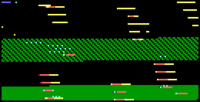RBJ (Redcode oBJect)
RBJ format belongs to XRK - Extra Redcode Kit, a complete Core Wars system for DOS by Marco Pontello. RBJ files contains an assembled binary version of a Redcode Warrior, usually written by the XRA - Extra Redcode Assembler. RBJ files also contains info about the warrior's author, name and version of the assembler used, date & time.
Contents |
File structure overview
An RBJ file is composed of 3 sections: Header, Code, Tail
The Tail is represented by 1 byte used as a checksum. To verify the integrity of a RBJ file, simply compare this value to the calculated checksum of the first (filesize - 1) bytes (that is Header + Code).
Structure Descriptions
Int = 2 bytes in Little-endian format.
Header
The Header is 75 bytes long, and is composed as follow:
Pos Field Len Data --------------------------------- 0 Version ID 1 Byte - decimal 1 Author 30 Chars 31 Made with 30 Chars 61 Serial Date&Time 8 FP64 69 Split Flag 1 Byte 70 Reserved 1 Byte 71 Program Len 2 Int 73 Start 2 Int
Code
The Code block is a sequence of (Program Len) blocks as follow:
Field Len Data
---------------------------------
0 Command 1 Byte
+1 Mode A / B 1 Byte
+2 Operand A 2 Int
+4 Operand B 2 Int
Tail
One Byte as a checksum:
Field Len Data
---------------------------------
0 CheckByte 1 Byte
---------------------------------
Fields Descriptions
Header
Version ID
Decimal (Major ver. * 10 + Minor ver.) Ex: 12 = v1.2
Author
Warrior's programmer Name/Nick
Made with
Assembler used
Serial Date&Time
Floating Point value: Dec * 86400 = seconds from midnight / Int = days from some date
Split Flag
0 = No SPL opcode used (program doesn't split) !0 = Program may use SPL
Reserved
Not used
Program Len
Instructions count, length of the code block
Start
Point to the instruction where execution start
Code
Command
0 DAT 1 MOV 2 ADD 3 SUB 4 JMP 5 JMZ 6 JMN 7 DJN 8 CMP 9 (not used) 10 SPL
Mode A / B
Field A = low nibble Field B = high nibble 0 "#" Immediate 1 "$" Direct 2 "@" Indirect 3 "<" Indirect autodecremented
Operand A & B
2 bytes signed integer
Tail
CheckByte
Here's how to calc the checksum byte (in BASIC-like pseudocode):
Sum = 0
FOR i = 1 TO BufferLen STEP 1
Sum = Sum + BufferByte(i)
NEXT i
FOR i = 1 TO BufferLen STEP 2
Sum = Sum + BufferByte(i)
NEXT i
FOR i = 1 TO BufferLen STEP 3
Sum = Sum + BufferByte(i)
NEXT i
FOR i = 1 TO BufferLen STEP 4
Sum = Sum + BufferByte(i)
NEXT i
Sum = Sum AND 255
